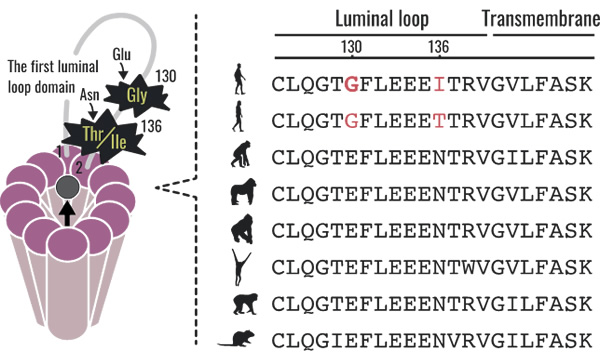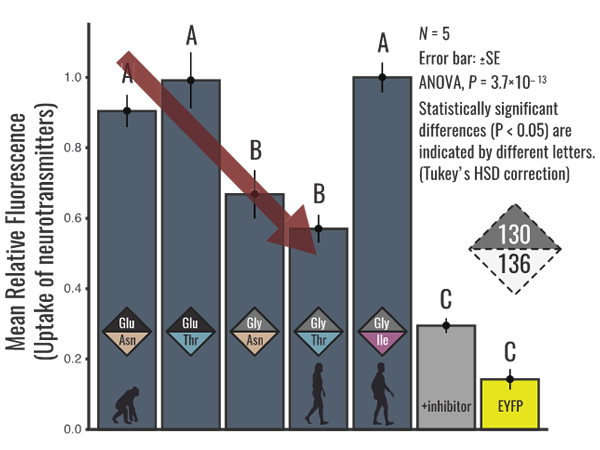Activities
- Home
- Activities
- Release
- Evolutionary changes in neurotransmitter uptake of VMAT1, possibly having made us prone to anxiety
Dec 2, 2019
Evolutionary changes in neurotransmitter uptake of VMAT1, possibly having made us prone to anxiety
Published in BMC Evolutionary Biology
Neurochemicals such as serotonin and dopamine play crucial roles in cognitive and emotional functions of our brain. Vesicular monoamine transporter 1 (VMAT1) is one of the genes that transport neurotransmitters and regulate neuronal signaling. A research team led by Dr Masakado Kawata in Tohoku University has reconstructed ancestral VMAT1 proteins and revealed the functional changes in neurotransmitter uptake of VMAT1 in the course of human evolution.
The research group previously discovered VMAT1, which encodes vesicular monoamine transporter 1, as one of the genes evolved through natural selection in the human lineage, with two human-specific mutations (130Glu->Gly and 136Asn->Thr/Ile; Figure 1). In the present study, by reconstructing ancestral VMAT1 proteins and applying a fluorescent substrate to visualize and quantify the neurotransmitter uptake of each genotype, they showed that an ancestral (130Glu/136Asn) VMAT1 protein exhibited increased uptake of neurotransmitters compared to a derived (130Gly/136Thr) genotype (Figure 2). Given that the derived (130Gly/136Thr) genotype is shown to be associated with depression and/or anxiety in modern human populations, this suggests that our ancestors may have been under natural selection favoring higher susceptibility to external environment. Moreover, it would also be of interest that the 136Ile, associated with less psychopathological symptoms, has emerged later in our history, possibly indicating the reversal of selective pressure towards our psychological phenotype.

Figure 1. VMAT1 (vesicular monoamine transporter 1) has two human-specific mutations in its amino acid sequence, 130Glu->Gly and 136Asn->Thr. The 136Ile variant has additionally emerged recently, putatively along with Out-of-Africa migration of modern humans.

Figure 2. Comparison of neurotransmitter uptake among ancestral and derived genotypes of VMAT1 proteins.
Please visit the link below for further information.
Human-specific mutations in VMAT1 confer functional changes and multi-directional evolution in the regulation of monoamine circuits.
Daiki X. Sato, Yuu Ishii, Tomoaki Nagai, Kazumasa Ohashi, Masakado Kawata
BMC Evolutionary Biology, 2019, 19:220
BMC Evolutionary Biology
https://bmcevolbiol.biomedcentral.com/articles/10.1186/s12862-019-1543-8
